Rural India has been shortchanged from reaping the gains of freedom and national development by way of continuously adverse terms of trade between town and country. A visitor from another planet is likely to identify rural Bharat as a totally different country from urban India with its swish motorcars, glitzy shopping malls and big weddings – writes Dilip Thakore
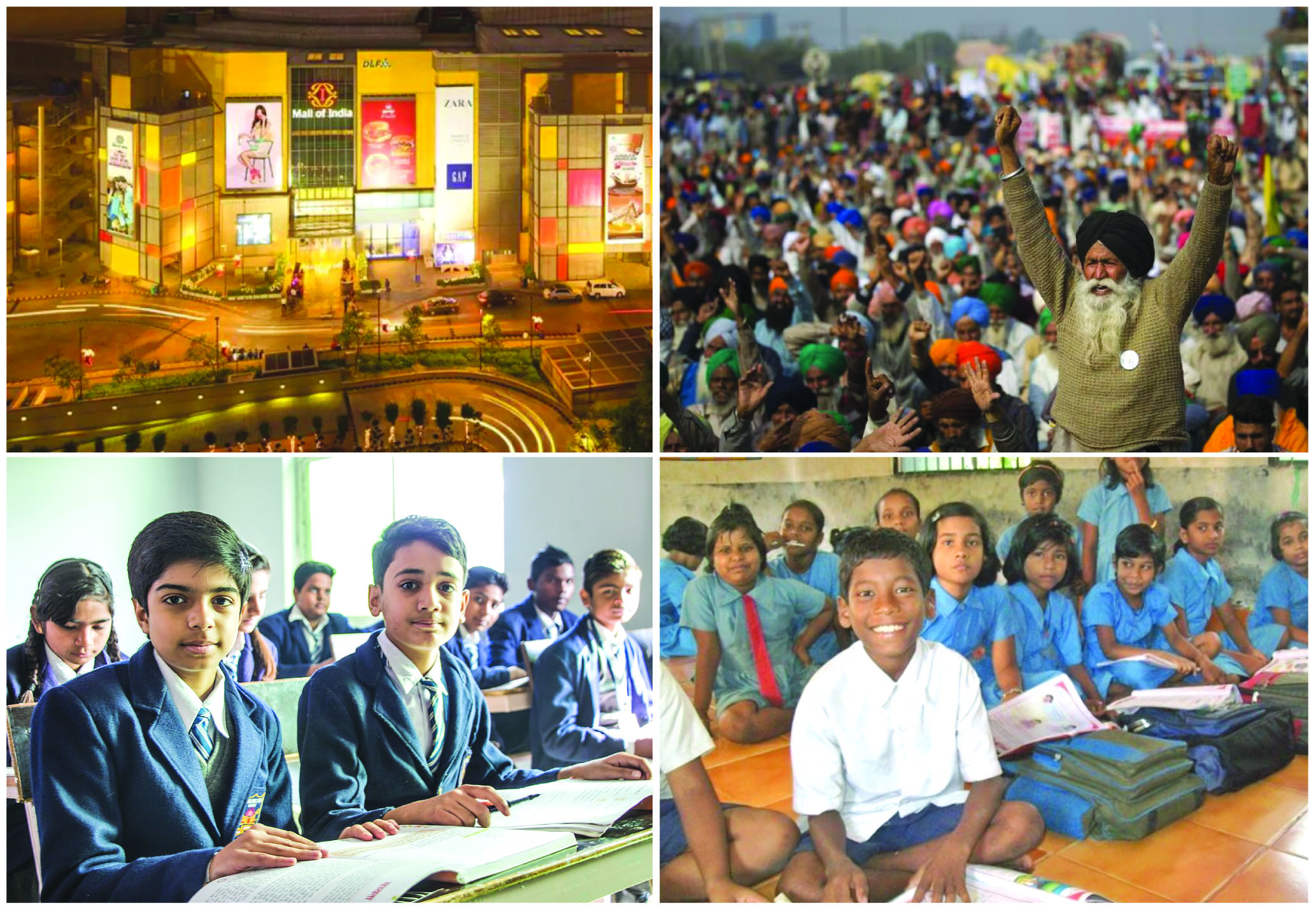
Vignettes of India & Bharat: different countries
The latest stand-off between rural and urban India on the Punjab-Haryana border is yet another confrontation between Bharat’s impoverished rural majority and relatively wealthy urban India. Currently, thousands of farmers mainly from rural Punjab grouped under the banners of the SKM (non-political), BKU (Dallewal), Kisan Mazdoor Morcha and 17 other farmers’ organisations are on the march to New Delhi to press for legally guaranteed minimum support prices (MSP) 50 percent above the weighted average cost of production for wheat, rice and 21 other crops. Other demands include better sugarcane prices, pension of Rs.10,000 per month for every farmer and farm labour above 60 years of age, and India’s withdrawal from the WTO (World Trade Organisation).
To prevent the entry of droves of farm protestors with tractors into the national capital disrupting administration and business, the Central and (BJP) government of Haryana have strongly barricaded the border with Punjab and large contingents of the police, RAF (Rapid Action Force) and CRPF (Central Reserve Police Force) to halt the farmers’ march to Delhi. Four rounds of talks between representatives of the BJP government at the Centre and farmer leaders to negotiate a compromise have proved unsuccessful at the time of writing.
It’s pertinent to note that this movement follows massive protests of farmers three years ago in 2020, when grouped under the banner of the Punjab-based Samyukta Kisan Morcha, All India Kisan Sangharsh Committee and over a dozen other unions and associations, farmers congregated on the borders of the national capital to protest three Bills passed by Parliament. These Bills permitted the purchase and sale of agriculture produce beyond officially designated Agriculture Produce Marketing Committee premises (aka mandis); electronic trading of farm produce to create a national market; contract farming and empowered the Central government to regulate farm produce prices only in the event of extraordinary emergencies such as war and famine.
Essentially these Bills were enacted to apply the logic of the highly successful deregulation and liberalisation of Indian industry in 1991, to the farming sector. However, they were fiercely opposed by the farmers’ unions who continued their protest on the Delhi border for over a year — during the height of the Covid pandemic crisis. This protest was supplemented with protests in Punjab, Haryana as also pro-farmer protests in Tamil Nadu, Odisha and Kerala. Railway services remained suspended in Punjab for over two months. The adamant refusal of the farmers unions to budge from their demand and continuous camping on highways encircling Delhi forced the Union government to repeal the three Bills in November 2021.
Predominantly an agriculture economy which was by-passed by the Industrial Revolution of the 18th and 19th centuries, the Indian subcontinent has a long history of peasant revolts in the 20th century including the Champaran (1917), Kheda Satyagraha (1918), Bardoli Satyagraha (1925) and Tebhaga Movement (1946-1947). Moreover there’s a mountain of evidence emerging that the worst excesses of the British Raj — heavy coercive taxation by comprador zamindars; uprooting of traditional mixed farming and forced cultivation of monoculture plantation crops including indigo and opium (see book review p.78) were inflicted upon India’s peasantry who constituted 80 percent of the population until the dawn of independence. Unfortunately, it is insufficiently documented by post-independence historians that it was resolute rural and peasant support astutely mobilised by Mahatma Gandhi in the 20th century, that enabled India to free itself from almost two centuries of deeply exploitative British rule.
In the 21st century with the Indian diaspora in the UK having grown to a large and visibly content minority and a prime minister of Indian origin presiding over formerly imperial Great Britain — both of which could be interpreted as acts of atonement — it’s easy to forget that average GDP growth during almost 200 years of the British Raj over India was one percent per year; the average lifespan of Indians was 31 years, and public health and education were almost totally neglected in the rural hinterlands of the subcontinent. These realities are scarcely documented by post-independence India’s historians.
Therefore, after the dawn of independence when free India embarked upon its “tryst with destiny”, quite rightly India’s rural majority which at that time contributed 60 percent of the country’s GDP, expected rural growth to become the focus of national development. This was the ideal of Mahatma Gandhi, prime architect of India’s unique and unprecedented freedom struggle based on satyagraha (truth) and ahimsa (non-violence) which completely flummoxed our erstwhile British masters and prompted their hasty, unlamented departure from Indian shores. Gandhi advocated rural-led national development with “village republics” stimulating agriculture productivity and generating surpluses to finance employment generating rural MSMEs (micro, small and medium enterprises). These in turn would generate employment and demand for consumer goods necessary for the growth and development of industrial conglomerates led by pioneer Indian entrepreneur-industrialists G.D. Birla, J.N. Tata, Ambalal Sarabhai, Walchand Hirachand, Lala Shri Ram among others, who had funded the freedom movement. This village-led development model was ridiculed by the post-independence Congress party leadership and constitutionalists including prime minister Jawaharlal Nehru and Dr. B.R. Ambedkar.
On the contrary, Jawaharlal Nehru, free India’s first prime minister imposed the Soviet Union’s centrally planned heavy industry development model with which he became enamoured in the fashionable salons of Bloomsbury Square, London — his education in Harrow School, London and degree in natural sciences from Cambridge University was totally divorced from economics — upon post-independence India.
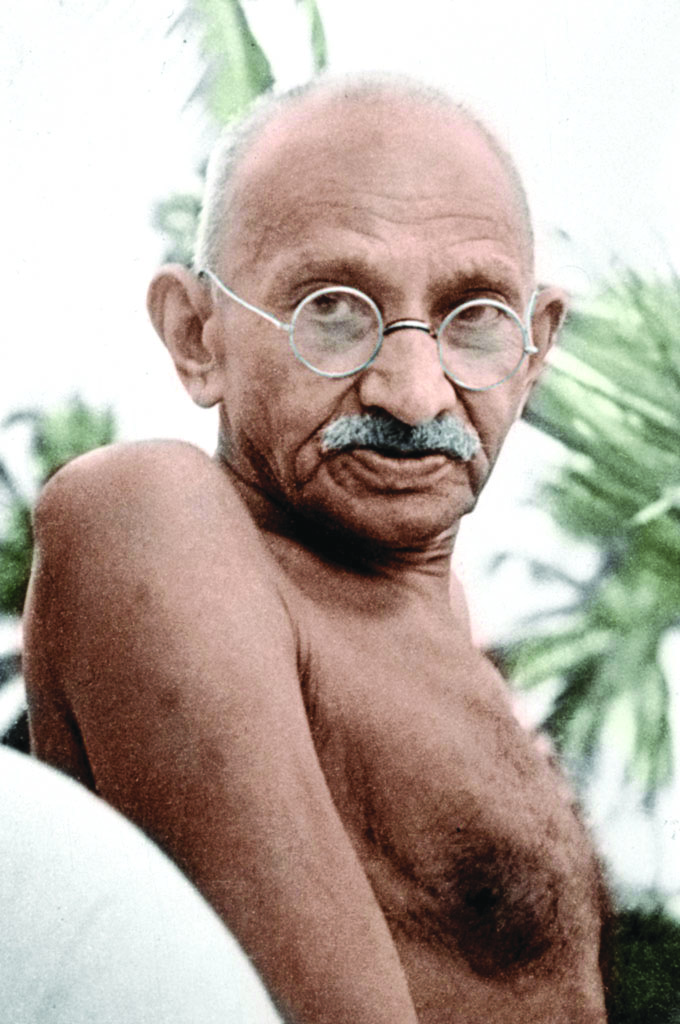
Gandhi: rural growth focus
This translated into the promotion of capital-intensive public sector enterprises (PSEs) for the production of coal, steel, electricity, chemicals and fertilizers and building large dams for irrigation projects. The model also mandated imposition of rigid growth and development constraints upon private industry, and on the country’s pioneer industrialists who were poised to establish their footprints countrywide and across Asia.
This economy development model driven by the Planning Commission and elaborate five-year plans necessitated vacuuming meagre rural savings for investment into government owned PSEs which were forecast to generate vast profits for investment into rural infrastructure development and social welfare (public health and education).
Unsurprisingly, the country’s 256 Central PSEs — and an equal number promoted by state governments — driven by business-illiterate bureaucrats and over-promoted clerks, proved to be a disaster and failed to generate the surpluses (‘profit’ was — and remains — a bad word in the official lexicon) for investment in rural growth and development. The outcome was disastrous. In the early 1960s when two successive monsoons failed, there was a sharp fall in foodgrains production and India became heavily dependent upon grain imports from the United States which gave them away at humiliating throwaway prices under its PL-480 programme. In popular parlance, newly-independent India transformed into a ‘ship-to-mouth’ economy.
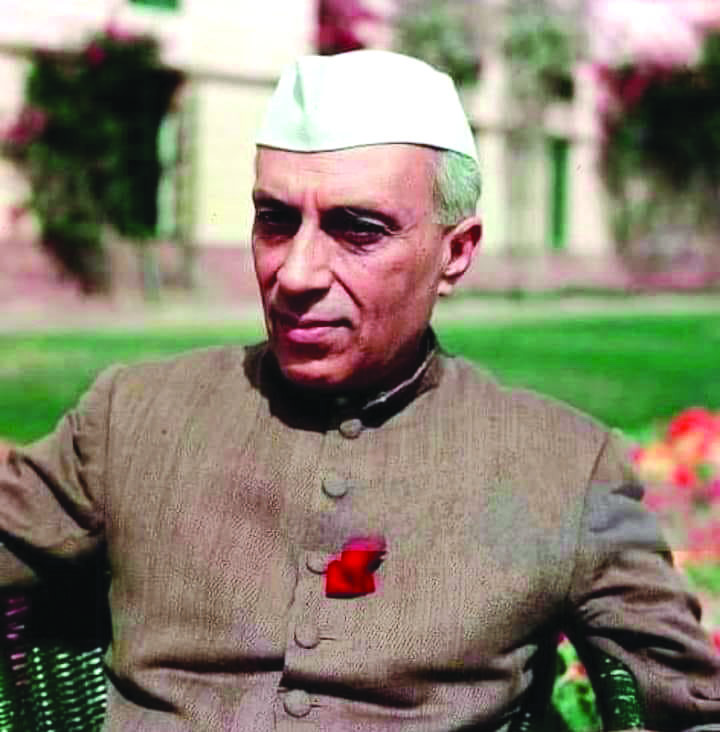
Nehru: heavy industry model
Despite the public sector-led heavy industry model failing to deliver the surpluses predicted by the country’s first two roseate Soviet-style five-year plans, the Congress party under Nehru’s influence refused to change tack. In the early 1960s three eminent economists — Prof. P.R. Brahmananda, C.N. Vakil and B.R. Shenoy — proposed a shift from the heavy industry to a light wage goods production model through promotion of thousands of labour-intensive light consumer and intermediate products enterprises which would generate mass employment and consumer goods demand required for economic growth. However this proposal was rejected and Nehru’s daughter Indira Gandhi who succeeded him as prime minister in 1965, nationalised the coal industry, the country’s major banks and for a while the foodgrains distribution trade.
Fortuitously, with the introduction of dwarf variety Mexican wheat by American agri-scientist Dr. Norman Borlaug and popularised by Dr. M.S. Swaminathan, India’s Green Revolution miraculously transformed Indian agriculture, and annual foodgrains production centred in perennially irrigated Punjab, Haryana and Western Uttar Pradesh, spurted from 79 million tonnes in the 1960s to over 100 million tonnes in 1971. Despite this, the PSEs-dominated economy grew at a rock-bottom 3.5 percent per year which was offset by annual population growth of 2.1 percent — the consequence of inadequate investment in public education.
Since then, India’s annual foodgrains production has crossed 300 million tonnes. Undoubtedly, farmers in these states and regions have prospered, but modestly because of higher fuel prices after OPEC raised crude oil prices exponentially in 1973 and 1979, and continuously adverse terms of trade between town and country. Incomes and standards of living of farmers in other 26 states of the country suffer in comparison with Punjab farmers because the latter have been provided minimum support prices for the foodgrains — wheat and rice — that have made ‘ship-to-mouth’ India self-sufficient in foodgrains production.

Kaushal: budget wrecking proposal
Somewhat paradoxically, Punjab’s relatively wealthy farmers are in the forefront of the agitations which forced the Central government to repeal the three farm Bills of 2021, and also in the current agitation for legally guaranteed minimum support prices for 23 crops plus several other demands mentioned above which have the potential to wreck the Union budget. “If they had done their maths, representatives of the 200 farmers’ unions participating in the latest protests would have realised that GoI (government of India) cannot meet their list of demands without risking a severe fiscal crisis, sabotaging rural banks and disincentivising and disrupting (internal) migration which is the bedrock of farming in the three states.
Giving in to famers’ demands would be most irresponsible,” wrote Dr. Neeraj Kaushal, professor of social work at Columbia University, USA, in the Economic Times (February 16).
Dr. Kaushal’s viewpoint that the latest set of demands made by farmers from the country’s most prosperous agriculture belts are over the top and cannot be conceded without severe damage to the Indian economy and to Indian agriculture itself, is endorsed by most economists.
High MSP for wheat and rice producers in the northern foodgrains producing states will discourage Punjab-Haryana farmers from switching from water and chemical fertilizer-intensive foodgrains production, which has severely degraded the soil in these states. Moreover doubling the minimum wage of rural labour under MGNREGA as demanded by the agitating farmers is certain to hurt Punjab and Haryana farmers most as it will “disrupt” the migration of agriculture labour from other states to Punjab/Haryana, as argued by Dr. Kaushal. Likewise, the demand that India withdraws from the WTO will rule out Indian farm produce exports forever. Other demands contained in the protesting farmers charter such as pensions of Rs. 10,000 per month for all farmers and farm labour over 60 years of age is likely to spiral Central and state governments revenue expenditure, leaving very little capital spending to build rural infrastructure, essential for long-term viability of Indian agriculture.
Nevertheless, these extreme demands made of farm union leaders are understandable because the plain truth is that despite suffering the worst excesses of colonial exploitation and providing unstinting support to India’s unprecedented freedom movement, there’s no denying that rural India has been continuously short-changed on the issue of reaping the gains of freedom and national development by way of adverse terms of trade between town and country. As a result MPCE (monthly per capita expenditure) of rural citizens at Rs.3,773 is half of urban Indians (Rs.6,459).
The pathetic standard of living of the vast majority of rural citizens is also reflected in the abysmal infrastructure of the hinterland. Motorable roads, public transport, health centres, functional schools and higher education institutions, law and order personnel are conspicuously absent in India’s provincial landscape.
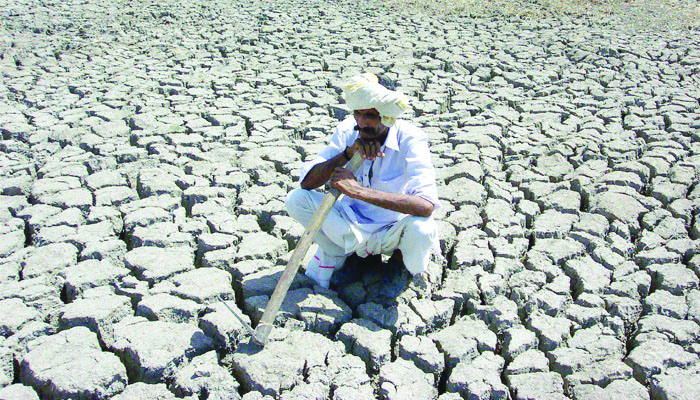
Devastated Maharashtra farmer: popular media depiction
Indeed a visitor from another planet is certain to identify rural Bharat whose residents are differentiated by clothing, premature ageing, and visible malnutrition, as citizens of a totally different country from urban India with its swish motor cars, glitzy shopping malls and big weddings. The vast majority of citizens of Bharat plainly lack the confidence of free and equal citizens. The popular depiction of them in the media is of wisened turbaned ryots supplicating urbanised political leaders for hand-outs.
Urban liberals and lefties in particular, never tire of highlighting that leaders of the current and former farmer agitations are ‘rich’ farmers, recipients of free electricity plus water and fertiliser at subsidised prices. Yet the reality is that rich farmers are wealthy only when compared with other farmers living in sub-standard housing and struggling to put two square meals on the table. According to Anil Thakore, a graduate of the Royal College of Agriculture, Cirencester, UK and College of Tropical Agriculture, University of West Indies, a rural rich farmer “cannot attain the standard of living of a senior government clerk”.
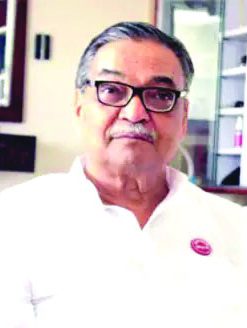
Sharad Joshi: single point agenda
After graduation, Thakore returned to farm in India. He purchased and managed a 20-acre dairy and horticulture farm in Hesarghatta, 20 km from Bangalore. “Despite excellent yields, it was impossible to get above cost-of-production prices in the Bangalore market. All agriculture produce had to be compulsorily auctioned in government APMC (Agriculture Produce Marketing Commission) yards, where rock-bottom prices were rigged by a cartel of wholesalers. Selling directly to retailers was very expensive because of high petrol/diesel prices. Moreover, there was always a setback of either low rainfall or pest attacks and produce theft. Crop insurance was difficult and expensive,” recalls Thakore, who after a decade of “back-breaking effort” quit farming to establish a successful agriculture machinery manufacturing enterprise. “Profitable farming is impossible in India without MSP calculated at above input costs,” he says.
This assertion was vigorously endorsed by Sharad Joshi (1935-2015) who resigned a senior position with the United Nations in the early 1980s and returned to India to cultivate an inherited 40-acre farm in Chakan zilla of Nashik district in the heart of Maharashtra’s onion production belt. After several years of fruitless labour, Joshi founded the Shetkari Sanghatana, a farmers’ movement with a single-point agenda — remunerative prices for farm produce. An economist fluent in three languages who had studied agriculture economics while serving the UN, Joshi was the first farmers’ leader to articulate the India vs. Bharat divide and expose “systematic exploitation of India’s rural majority”.
According to Joshi, suppressed prices for farm produce are inherent in the centrally planned Soviet-inspired heavy-industry development model which necessitates low farm produce prices to provide cheap food for the urban proletariat. Joshi was perhaps the first peasants leader to highlight the official policy of prohibiting exports of cotton, pulses, onions and other agriculture produce when prices rise and dampening high domestic prices by resorting to imports to prevent farmers reaping windfalls. In particular, through several highly successful mass farmers’ agitations, the Shetkari Sanghatana was successful in securing minimum support prices for cotton and onion producers in Maharashtra from NAFED (National Agriculture Cooperative Marketing Federation).
But Joshi paid a heavy price for moving from the comforts of New York to Chakan village. His wife died by suicide and after over a decade of struggle for remunerative prices for farm produce, Joshi threw in the towel, was co-opted into the establishment by the Rajiv Gandhi government and appointed chairman of the toothless Delhi-based Commission for Agriculture Costs and Prices (CACP).
In December 2015, Joshi (whom your correspondent featured in a India vs. Bharat cover story in BusinessWorld in 1983) passed away in Delhi, his mission unfulfilled. Onions are not included in 23 crops for which SKM farmers are demanding minimum support price. On the contrary with onion prices firming up in India, in August last year a 40 percent duty was imposed on onion exports depriving Indian farmers the advantage of high prices abroad.
Even as Sharad Joshi emerged as a provincial leader in Maharashtra, up north, in 1986, Mahendra Singh Tikait was elected president of the Bharatiya Kisan Union (BKU) in Uttar Pradesh — India’s most populous (215 million), and socio-economically backward state. But although Tikait emerged as a formidable farmers’ leader and led over “60 farmers movements” including a famous rally at the Boat Cub in Delhi that swamped the national capital in 1986, forcing the Rajiv Gandhi government to decree higher prices for sugarcane and waiver of electricity charges in UP, after Tikait’s demise the farmers movement in the north also lost its momentum. The demands of Punjab/Haryana farmers in 2021 and currently for better prices for farm produce supplemented with a host of other grievances are reflective of the frustrations of India’s rural majority continuously denied living standards equivalent with their urban counterparts.
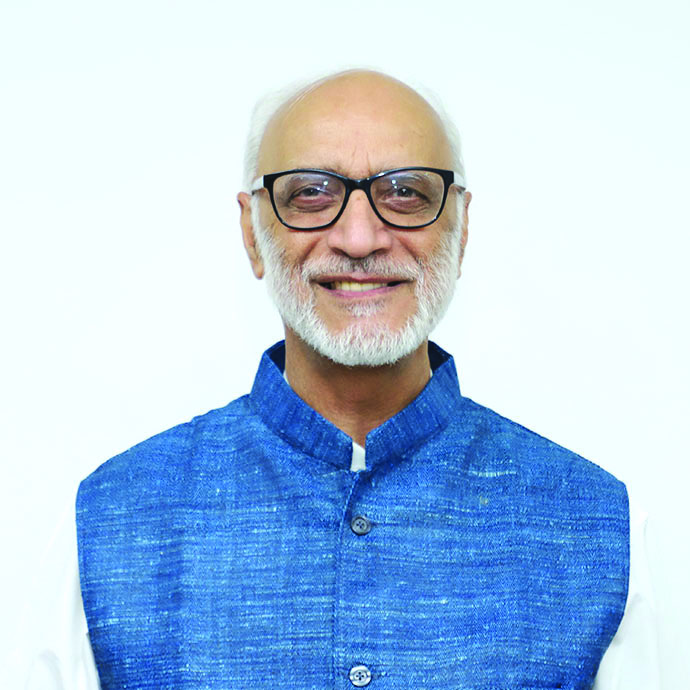
Gulati: mindset change call
In this connection it’s pertinent to remember that under Soviet dictator Josef Stalin’s compulsory procurement of farm produce prices to feed the urban proletariat, over 30 million peasants died of starvation in the 1930s. Likewise an estimated 30-45 million Chinese peasants perished during Chairman Mao’s Great Leap Forward initiative of 1958-65. In democratic India, farmers didn’t die of starvation as much as by prolonged malnutrition, i.e, millions became ‘dead men walking’ even as paying rock-bottom prices for agriculture produce, urban India’s bourgeoisie has transformed into the world’s largest middle class whose number is estimated at 430 million.
That farm produce prices have been deliberately suppressed for over seven decades is admitted by a minority of economists. “The first and foremost policy action that is needed is to remove all bans on agri-exports, stocking limits on private trade, and stop unloading wheat and rice in the open market at below the economic cost of the Food Corporation of India (FCI). These are all anti-farmer policies designed to favour consumers. The fundamental problem of today’s agri-food policies is that they are highly tilted towards consumers at the cost of farmers. This mindset needs to change, especially when the government claims that just 11 percent of the population lives under poverty,” says Dr. Ashok Gulati, former chairman of the Commission for Agricultural Costs and Prices (CACP) and currently Infosys chair professor for agriculture at the Indian Council for Research on International Economic Relations (ICRIER), in a revealing op-ed essay written for the Indian Express (February 19).
Curiously even though a small and growing minority of establishment economists are becoming aware of egregious India vs. Bharat inequality, they seem to suffer a blind-spot about the unkindest cut of all inflicted upon the country’s rural majority: a conspicuous failure to nurture the development of a vigorous food processing and post-harvest industry. Although it’s common knowledge that 20 percent of the country’s horticulture and 10 percent of foodgrains production valued at Rs.10,000 crore rots because of under-development of a down-stream food processing industry, Dr. Gulati, who has studied farm economies of over 50 countries, hasn’t commented on the huge loss of time, money and effort suffered by India’s farmers because of this policy failure.
In addition to a fifth of the country’s annual fruits and vegetables produce rotting before it gets to market, it’s pertinent to also note that over 10-15 million tonnes of foodgrains stored in the archaic godowns of the public sector Food Corporation of India rot or are consumed by rodents. Against this, only 5-10 percent of farm produce in the US and Brazil and European countries is allowed to perish because non-table quality horticulture produce is quickly purchased, processed and marketed by giant food processing multinationals such as Del Monte, Cargill and Kellogg.
Surprisingly, Indian policy formulators and learned economists are reluctant to draw lessons from a home-grown farm produce success story — the rise and rise of the Amul milk products brand which visionary farmers champion, the late Dr. Verghese Kurien (1921-2012) launched in the 1960s, and is arguably the country’s most famous and loved FMCG (fast moving consumer goods) brand.
As the first chairman of the National Dairy Development Board (NDDB), Kurien persuaded the Central government to canalize all milk and dairy surpluses of the European Union which were proposed to be dumped as aid to India, to NDDB. By carefully calibrating the release of imported milk and dairy products into the Indian market at market price, NDDB mobilised capital for investment into milk and dairy processing technology for the Gujarat Cooperative Milk Marketing Federation (GCMMF), which promoted the Amul brand.
This technology enabled GCMMF to purchase Gujarat farmers’ surplus milk in the flush winter season at above cost price, convert it into milk powder which was ‘recombinated’ into milk and sold in the summer season of milk shortage at steady prices. Through this stratagem GCMMF was able to pay dairy farmers market prices for milk through the year. Winter surpluses were also converted into butter, cheese, paneer, margarine etc, to ensure that “not a drop of milk was wasted”. After the success of GCMMF and Amul, NDDB promoted successful dairy farmers cooperatives countrywide as a result of which chronically milk-deficient India of the 1960s has transformed into the world’s largest producer of milk and dairy products.
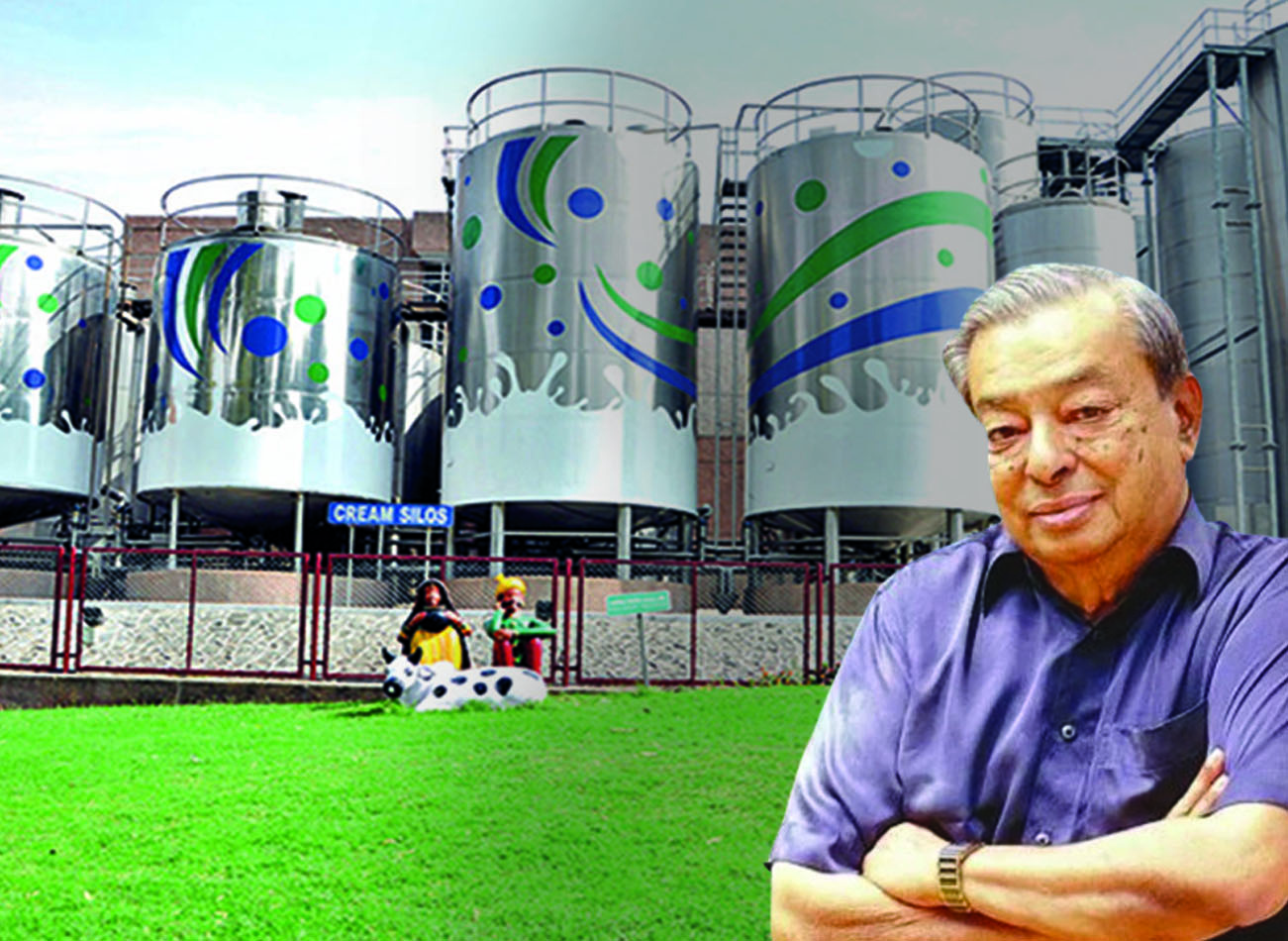
NDBB hi-tech milk processing plant in Gujarat. Inset: Dr. Verghese Kurien
Yet instead of this dairy farmers’ champion being hailed as a hero and role model, Kurien was fiercely criticized by communists and leftists in Parliament and the media as a ‘foreign agent’. In 1984 as editor of BusinessWorld magazine, your correspondent wrote a detailed cover feature titled ‘Operation Flood: Case for the defence’ which narrated the facts and circumstances of Kurien’s heroic conversion of chronically milk deficient India into the world’s largest producer of milk and dairy products, which shut them up good and proper.
However, despite this model which in effect provides dairy farmers minimum support prices without government intervention being available for replication for farm produce, and horticulture products in particular, for mysterious reasons it has not been permitted to strike root. On the contrary R.N. Bhaskar, former consulting editor of Business India and prolific blogger, suspects an establishment conspiracy to erase the history of Dr. Kurien’s astonishing metamorphosis of India’s dairy industry (see [email protected]). Although Kurien himself tried to replicate the successful Amul model for the oilseeds and horticulture sectors, these ventures failed.
One explanation of the continuous failure of independent India’s rural majority to get remunerative prices for farm produce is that under the Constitution, agriculture is essentially a States list subject, although some sectors are listed in the Concurrent list. Some monitors of the paradox of a primarily agriculture economy failing to develop a downstream food processing industry attribute it to the disproportionate influence that agriculture wholesalers and middlemen exercise in the corridors of power of state governments. These middlemen (usually kith and kin of politicians and bureaucrats) are totally averse to close agriculture-industry connect which would result in forward markets and contract farming. For decades, they have ensured that only small and micro sector enterprises — rather than organised sector corporates — are licensed to enter the agri-produce processing business.
This hypothesis is supported by the fact that among the several demands of SKM farm leaders is prohibition of modern warehousing facilities being established by the Adani Group, and proscription of forward markets and contract farming which would permit large corporates to monetise food production in a big way.
Farm leaders seem unaware that closer linkages between farms and factories is necessary for the growth of a viable agri-produce processing industry, and cutting out the string of middlemen who multiply farmgate prices eight-tenfold before farm produce — especially perishable fruit and vegetables — reaches the consumer. Closer farm-factory linkage is also necessary to stimulate crop diversification and break the status quo which is heavily despoiling land quality in the foodgrains growing states of Punjab, Haryana and western Uttar Pradesh.
Moreover, perhaps an even greater injustice visited upon the country’s majority in rural Bharat by India’s central planners, policy formulators and ruling establishment is the open, continuous and uninterrupted neglect of education.
For over three decades the Annual Status of Education Report (ASER) published by the highly reputed Pratham Education Foundation (estb.1995) which home (not school) tests large samples of primary children countrywide through a huge (15,000-20,000) army of volunteers — mainly college students — for basic literacy and numeracy, has been reporting that over 50 percent of class VII-VIII children in rural India can’t read class II textbooks with sufficient fluency and comprehension in their own vernacular mother tongues, let alone ‘Inglish’, the national link language and language of business, commerce and law.
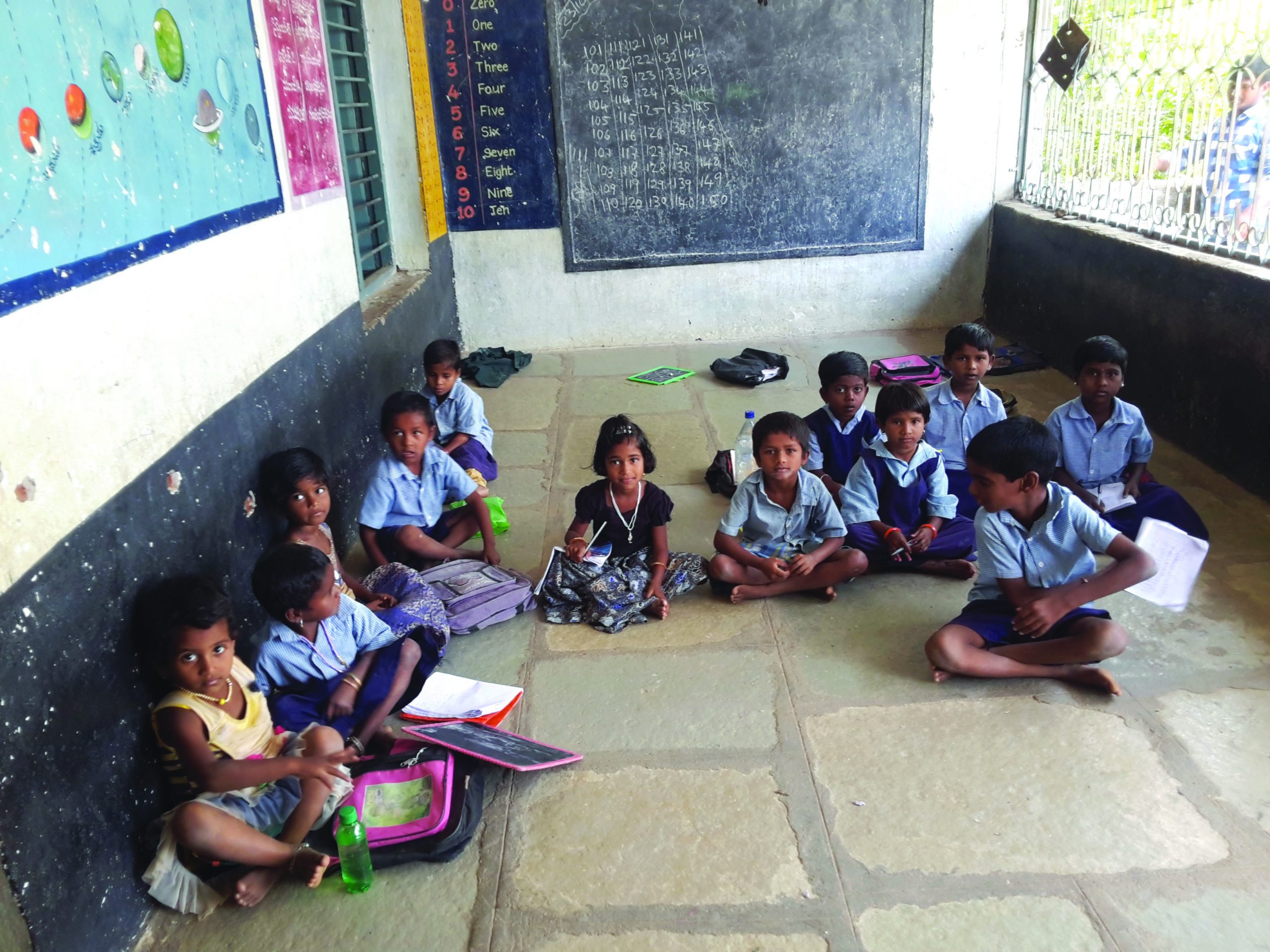
Village school in Telangana: open, continuous & uninterrupted neglect
Conterminously EducationWorld (estb.1999), with the mission to “build the pressure of public opinion to make education the #1 item on the national agenda”, has been persistently pressing for the annual budgetary expenditure (Centre plus states) for public education to be raised to 6 percent of GDP, a recommendation made by the high-powered Kothari Commission in 1967. Despite your editors annually presenting a schema — coinciding with presentation of the Union Budget — for the Centre to raise an additional Rs.7 lakh crore per year, national education expenditure has remained mired in the 3-3.5 percent of GDP rut for 75 years.
Moreover, pathetically meagre outlays for rural government schools are recklessly misspent. Over 85 percent goes towards the high remuneration of ill-qualified and indifferent teachers — 25 percent of government school teachers countrywide (1.25 million), largely drawn from kith and kin of politicians and bureaucrats, are absent every day. The country’s 1.10 million government — especially rural — schools are notorious for dilapidated buildings, lack of furniture, multi-grade teaching, inadequate toilets, drinking water and often electricity. Likewise, rural India’s few and far between higher education institutions (undergrad colleges and state government universities) are only marginally better, and nonchalantly certify millions of unemployable youth who stream into industry and the services sector. Very few college graduates return to farms.
And despite reckless government, establishment, and academia negligence to develop India’s abundant and high-potential human resource, there’s no shortage of economists on television news channels and in the print media who opine that the national development effort necessitates massive migration of rural youth to urban industry. The uncomfortable question about the employability of millions of illiterate, quasi-literate and unskilled (India hosts 5,000 vocational training institutes cf. China’s 500,000) is routinely fudged.
Academic and economics pros and cons aside, the swelling standoff between agrarian Bharat and urban India on the Haryana-Delhi border — the second in the past four years — should not be ignored as a confrontation of minor consequence. Although currently Bharat’s protest is led by a numerically small number of farmers under SKM (non-political) banner, it’s pertinent to note that some 200 farmer unions have made common cause with it. And recently the parent SKM which led the year-long successful confrontation in 2020-21 forcing the BJP government at the Centre to repeal the three farm Bills which it had legislated in 2020, has expressed its support. Simultaneously, other farmers’ representative organisations across the country are beginning to become restive.
In the circumstances, it’s high time to frankly admit that India’s rural citizens have been substantially sidelined in the national development effort and make amends to right the imbalance.
First, it’s time to cut through the nit-picking clutter of legally protected MSPs by establishing an agriculture produce stabilisation fund (suggested by Prof. A.S. Gulati of ICRIER quoted above) from which Central/state governments could draw to purchase crops whose prices fall below mutually agreed floor prices. Subsequently, these commodities could be sold through the subsidised PDS (public distribution system) and/or expeditiously auctioned to food processing companies to maintain the fund.
Secondly, all hurdles to establishing food processing enterprises should be immediately removed to reduce distress selling and colossal waste of farm — especially horticulture — produce. This also necessitates that all impediments to establishing modern warehousing units and stocking limits imposed on traders are removed.
Simultaneously, government needs to agree not to interfere by way of imports and export curbs when farm commodity prices rise. Like coffee and tea growers, all farmers should be entitled to make windfall gains when global prices firm up. Lessons need to be learned from neighbouring China’s example of facilitating the establishment of millions of TVEs (town and village enterprises) which have transformed agriculture-dependent China into the manufacturing hub of the world. In short, the logic of the 1991 liberalisation and deregulation which revived moribund Indian industry, needs to be applied to rural India.
Yet at bottom, delivering of high quality education in rural India — especially in government schools and colleges — is the essential precondition of bridging the India-Bharat divide. Population growth is accelerating fragmentation of already small rural farms (average size: 2.67 acres). This necessitates higher per-acre foodgrain yields which are currently one-tenth of US and European farms and one-fifth of China. In turn, this requires adequately schooled farmers rather than adults who can’t read a fertilizer or pesticide usage leaflet. It’s also time to accept that rural school-leavers exhorted by smug economists and media pundits to migrate to the factories and workplaces of urban India, need to be sufficiently qualified and skilled to become employable.
Even as triumphalist national leaders make loud claims of India’s fast growing economy and emerging as a global viswaguru (world teacher), the country’s short-changed rural majority, deprived of the gains of political freedom and feeble economic growth, is incrementally raising banners of revolt on highways leading to New Delhi and state capitals. Concurrently, a rising tide of ill-educated and unemployable rural youth is spreading across the country in the form of ‘migrant workers’ forced to work in low-paid jobs in the construction and services sector and increasingly taking to crime and violence.
These phenomena are a warning to the Central and state governments, the establishment and academia to pay greater attention to public — including skills — education in agrarian India. This is necessary to ensure that the widening India-Bharat fissure doesn’t become an unbridgeable divide
Farmers’ latest demands
The headline demand in the farmers’ 12-point agenda is for a law to guarantee minimum support price (MSP) for all crops, and determination of crop prices in accordance with the Dr. M.S. Swaminathan Commission’s report which calculated agri-produce prices by adding all input costs plus farmers’ labour. The other demands are:
- Full debt waiver for farmers and farm labour
- Implementation of the Land Acquisition Act of 2013, with provisions for written consent from farmers before acquisition, and compensation at four times the collector rate
- Punishment for the perpetrators of the October 2021 Lakhimpur Kheri killings
- India should withdraw from the World Trade Organisation (WTO) and freeze all free trade agreements
- Pensions for farmers and farm labour
- Compensation for farmers who died during the Delhi protest, including a job for one family member
- Electricity Amendment Bill 2020 should be scrapped
- 200 (instead of 100) days’ employment under MGNREGA per year, daily wage of Rs.700, and scheme should be linked with farming
- Strict penalties and fines on companies producing fake seeds, pesticides, fertilisers improvement
Repealed legislation: Missed opportunity
In June 2020, the BJP government at the Centre legislated and quickly enacted three important Bills which were later repealed (2021) because of prolonged (56 weeks) opposition from over 40 farmers organisations — mainly from the foodgrains (rice and wheat) growing areas of Punjab, Haryana and Western Uttar Pradesh — grouped under the banner of the Samyukta Kisan Morcha (SKM). These farmers staged determined opposition to the three Bills by camping on the Punjab-Delhi border where they were stopped by police and para-military of the Central government.
The SKM’s demand was that government should restrict trading in farm produce to government approved APMC (Agricultural Produce Market Committee) areas and declare annual minimum support prices (MSPs) at which government would be obliged to purchase 23 commodities including wheat and rice at the option of farmers. Since the legislation didn’t mention MSPs because the objective of the legislation was to create a competitive national market for farm produce, the negotiations failed. After the standoff between government and the protesting farmers resulted in a stalemate, the BJP government at the Centre withdrew and repealed the contentious legislation in November 2021.
The three Acts which were enacted — admittedly without adequate debate in Parliament — were:
Farmers’ Produce Trade and Commerce (Promotion and Facilitation) Act, 2020
- Expanded trade areas of farmers’ produce from APMCs to “any place of production, collection, aggregation”.
- Allowed electronic trading and e-commerce of farmers’ produce.
- Prohibited state governments from levying any market fee, cess, or levy on farmers, traders, and electronic trading platforms for trade of farmers’ produce conducted in an ‘outside trade area’.
Farmers (Empowerment and Protection) Agreement on Price Assurance and Farm Services Act, 2020
- Provided a legal framework for farmers to enter into pre-arranged (forward) contracts with buyers at agreed prices.
- Introduced a disputes resolution mechanism.
Essential Commodities (Amendment) Act, 2020
Removed cereals, pulses, potato, onions, edible oilseeds, and oils, from the list of essential commodities subject to government imposed price controls, abolished stockholding limits of agriculture and horticulture produce by traders, except in instances of extraordinary price rise.
Evidently the objective of these Acts was to enable wholesalers/traders countrywide to bid competitively for agriculture and horticulture produce. This would have had the effect of breaking the hold of APMC middlemen and commission agents over the trade in farm produce. India is unique in terms of the large number of middlemen operating between farmers and consumers which often results in the variation between the farmgate and retail prices being ten-fold. However in Punjab and Haryana, middlemen tend to be kith and kin of farmers and often provide quick loans for the purchase of farming inputs such as seeds, fertilisers and pesticides. Therefore, farmers in these states are reportedly disinclined to disturb the status quo.
Unsurprisingly, independent monitors of the Indian economy were in favour of the three Bills which have been repealed. Gita Gopinath, former Chief Economist of International Monetary Fund, opined the “farm bills and labour bills are very important steps in the right direction”. Sociologist Salvatore Babones, associate professor at the University of Sydney, expressed the opinion that the legislation would transform Indian agriculture from a “locally managed rural economy into a modern national industry”. Moreover in January 2021, 866 academics from several education institutes including Delhi, Gorakhpur, Rajasthan and Gujarat universities signed an open letter, expressing support for the three farm Bills.
However, Kaushik Basu, former chief economist at the World Bank, described the farm Bills as “flawed” and “detrimental to farmers”. In February 2021, 413 academics from across India and several foreign universities including Jawaharlal Nehru University, IIT-Kanpur, IIT-Madras, IISc Bangalore, Indian Statistical Institute Kolkata, Delhi University, Panjab University, IIT- Bombay, IIM-Calcutta condemned the legislation in a joint statement.
Although the academic community was divided on the impact of the three reform Bills, significantly, the Shetkari Sanghatana, a farmers’ union in Maharashtra established in the 1980s with a single point agenda — remunerative prices for farm produce — by the late Sharad Joshi (1935-2015) to ensure free markets for Maharashtra’s onion and cotton producers, supported the repealed legislation.
“Members of the Shetkari Sanghatana, the apex body of farmers in Maharashtra formed by the late Sharad Joshi, wants the market to play its role to decide the prices of agri commodities; it contends that MSP has actually weakened farmers, instead of empowering them. The Sanghatana is planning an agitation demanding that the government give freedom to farmers and stop intervening in the agri commodity market so that farmers will not have to depend on MSP,” wrote Radheshyam Jadhav, correspondent of Hindu Business Line (December 7, 2020)
It’s self-evident that when wholesale and retail traders countrywide are free to contract directly with farmers, farmgate prices which are currently way below retail prices, are certain to rise. Such direct connect is entirely feasible in the new age of ICT (information communication technologies). The bane of Indian agriculture is low — indeed distress — prices. Forward markets and contract farming is in the best interests of India’s farmers trapped in the low incomes mire. Pity their leaders don’t understand this.























